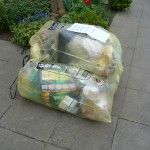The Mirror, Vol. 14, No. 689
When I moved to Cambodia in May 1990, there was hardly any garbage problem in Phnom Penh. According to my memory, public discussions about what to do with the increasing volume of garbage started only after the arrival of UNTAC in 1992. With the arrival of 22,000 UNTAC personnel, there was all of a sudden a lot of plastic, cardboard, and paper refuse – formerly, lotus and banana leaves, used at the markets to wrap fish or meat and others, did not present a problem: all these natural materials did rot and automatically returned into the recycling rhythm of nature. Now also metal cans and glass bottles contributed to increasing the total volume of garbage.
I remember a headline in The Cambodia Daily some time in 1994 or 1995: “Garbage, garbage, garbage” and one NGO even had organized a series of meetings, trying to get representatives of different sectors – city authorities, commercial organizations involved in the “production” of garbage, and of course affected citizens – around the same table to share and discuss possible responses to this new deluge.
Later, over the years, the problem of garbage was discussed in public mainly in relation to the fees due to the garbage collection arrangements by the Phnom Penh municipality and the contracted companies; there were also times when the payment or non-payment of fees for garbage collection was linked to the supply of electricity.
Recent press reports indicate that the problem of garbage is now being seen as a big challenge for which only systematic responses seem to be appropriate. The following report in The Cambodia Daily of 2 November 2010 explains the planned response – and some open questions.
Composting Facility Hitch in Waste Strategy
Public encouraged to separate refuse, but Phnom Penh still lacks processing tools
Phnom Penh has started a program to educate market vendors and the city’s households to sort organic and nonorganic refuse, officials said yesterday. However, they acknowledged that the city lacks composting facilities.
A waste management expert said it would be better to first develop a system for collecting and processing organic waste before encouraging the city’s inhabitants to begin separating their trash.
Ou San, chief of Boeng Keng Kang Market in Phnom Penh, said that, starting last month, vendors had been instructed to separate organic waste, such as animal and vegetable refuse, from dry waste, such as plastic bottles and cans. Mr. San said vendors were required to pack their organic waste in colorful plastic bags, while dry waste should be put into black bags. He said that separate containers for the different bags had been placed at the market since May.
Keang Lak, chief of O’Russei Market, said he had started fining vendors that did not follow the new rules, explaining fines started at $2.50. “vendors now have a duty to separate waste…. Or else they will face fines. Some vendors who have been fined have changed their attitudes,” he said.
.
.
.
.
.
.
.
.
A senior official at Phnom Penh Municipality who preferred not be named said that, in addition to requiring vendors at 15 markets to separate waste, the municipality would also launch a television advertisement to educate city residents about separating dry and organic waste…
The official then explained that despite encouraging a city – and nationwide – television audience to separate waste and implementing rules for separating waste at markets, Phnom Penh actually lacked a facility to process organic waste into compost. He said City Hall would like to develop such a facility at the Dangkao district dump site, which opened last year, adding however, there was no facility planned yet.
“The governor is hoping the new dumpsite will be a place for producing organic fertilizer,” the official said, without giving a timeline for this plan.
Chau Kim Heng, director of local waste management NGO Comped, welcomed City Hall’s initiative, but said it should first develop a facility to turn organic waste into compost and set up a system to collect separated trash, before starting an education campaign requiring the public to separate waste.
“They should make a master plan,” he said. `Then we can make a time frame for people to start separate [trash] by themselves; we can take one or two years to prepare the people.”
Some of the pictures here (which I took over the years while abroad) show that appeals to the public – and threats to be fined – can only bear practical results when the necessary infrastructure has been created first: facilities to properly separate garbage, and an elaborate system to collect the different types of garbage separately, so that they can also be dealt with separately: by recycling, and by disposing of them.
The next, and much more important step for the future will be to systematically start to reduce the production of garbage.
Have a look at the last editorial – you can access it directly from the main page of the Mirror.
And please recommend The Mirror also to your colleagues and friends.






Recent Comments